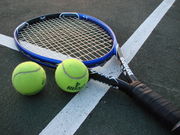The Championships, Wimbledon
| The Championships, Wimbledon | ||
|---|---|---|
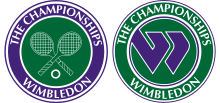 |
||
| Official web | ||
| Location | Wimbledon, London Borough of Merton UK |
|
| Venue | The All England Lawn Tennis and Croquet Club | |
| Surface | Grass / Outdoor (Except Centre Court during rain and consequently bad light when roof is already in play) | |
| Men's draw | 128S (128Q) / 64D (16Q)[1] | |
| Women's draw | 128S (96Q) / 64D (16Q) | |
| Mixed draw | 48D | |
| Prize money | £ 13,725,000 | |
| Grand Slam | ||
| Current | ||
The Championships, Wimbledon, or simply Wimbledon, is the oldest tennis tournament in the world and is considered the most prestigious.[2][3][4][5] It has been held at the All England Club in the London suburb of Wimbledon since 1877. It is one of the four Grand Slam tennis tournaments, and the only one still played on the game's original surface, grass, which gave the game of lawn tennis its name.
The tournament takes place over two weeks in late June and early July, culminating with the Ladies' and Gentlemen's Singles Final, scheduled respectively for the second Saturday and Sunday. Each year, five major events are contested, as well as four junior events and four invitational events.
The hard court Australian Open and clay court French Open precede Wimbledon in the calendar year. The hard court US Open follows. For men, the grass court AEGON Championships, also in London, as well as the Gerry Weber Open in Halle, Germany, serve as respective warm-up events. For women, the AEGON Classic in Birmingham and 2 joint events, the UNICEF Open in 's-Hertogenbosch, Netherlands and the AEGON International Eastbourne serve as warm-up events to Wimbledon.
Wimbledon traditions include a strict dress code for competitors, the eating of strawberries and cream, and Royal patronage. In 2009, Wimbledon's Centre Court was fitted with a retractable roof to prevent rain delaying and interrupting Centre Court matches during the tournament.
Contents |
History
Beginnings
The All England Lawn Tennis and Croquet Club is a private club founded in 1868, originally as 'The All England Croquet Club'. Its first ground was situated off Worple Road, Wimbledon.
In 1875, lawn tennis, a game devised by Major Walter Clopton Wingfield a year or so earlier and originally called 'Sphairistike', was added to the activities of the club. In the spring of 1877, the club was re-titled 'The All England Croquet and Lawn Tennis Club' and signalled its change of name by instituting the first Lawn Tennis Championship. A new code of laws (replacing the code until then administered by the Marylebone Cricket Club) was drawn up for the event. Today's rules are similar except for details such as the height of the net and posts and the distance of the service line from the net.
The only event held in 1877 was the Gentlemen's Singles, which was won by Spencer Gore, an old Harrovian rackets player, from a field of 22. About 200 spectators paid one shilling each to watch the final.
The lawns at the ground were arranged so that the principal court was located in the middle with the others arranged around it; hence the title 'Centre Court', which was retained when the Club moved in 1922 to the present site in Church Road, although not a true description of its location. However, in 1980 four new courts were brought into commission on the north side of the ground, which meant the Centre Court was once more correctly defined. The opening of the new No. 1 Court in 1997 emphasised the description. Wimbledon is widely considered to be the premier tennis tournament in the world and the priority of The All England Lawn Tennis Club, which hosts The Championships, is to maintain its leadership into the 21st century. To that end a long-term plan was unveiled in 1993, intended to improve the quality of the event for spectators, players, officials and neighbours.
Stage one of the plan was completed for the 1997 championships and involved building in Aorangi Park the new No. 1 Court, a broadcast centre, two extra grass courts and a tunnel under the hill linking Church Road and Somerset Road.
Stage two involved the removal of the old No. 1 Court complex to make way for the new Millennium Building, providing extensive facilities for the players, press, officials and members, and the extension of the West Stand of the Centre Court with 728 extra seats.
Stage three has been completed with the construction of an entrance building, housing club staff, museum, bank and ticket office.[6]
A new retractable roof was built in time for the 2009 championships, marking the first time in the tournament's history that rain will not stop play for a lengthy time on Centre Court. The All England Club tested the new roof at an event called A Centre Court Celebration on Sunday, 17 May 2009, which featured exhibition matches involving Andre Agassi, Steffi Graf, Kim Clijsters and Tim Henman. The first Championship match to take place under the roof was the completion of the fourth round Ladies' Singles match between Dinara Safina and Amélie Mauresmo. The first match to be played in its entirety under the new roof was between Andy Murray and Stanislas Wawrinka on 29 June 2009, which Murray won 2–6, 6–3, 6–3, 5–7, 6–3. The match in which Novak Djokovic defeated Olivier Rochus at Centre Court in the first round of the 2010 Championships recorded the latest ever finish at The Championships, concluding at 10.58pm By 1882, activity at the club was almost exclusively confined to lawn tennis and that year the word 'croquet' was dropped from the title. However, for sentimental reasons, it was restored in 1889 and since then the title has remained The All England Lawn Tennis and Croquet Club.
In 1884, the All England Club added Ladies' Singles and Gentlemen's Doubles. Ladies' Doubles and Mixed Doubles were added in 1913. Until 1922, the reigning champion had to play only in the final, against whoever had won through to challenge him/her. As with the other three Grand Slam events, Wimbledon was contested by top-ranked amateur players until the advent of the open era in tennis in 1968. No British man has won the singles event at Wimbledon since Fred Perry in 1936 and no British woman has won the Ladies Singles since Virginia Wade in 1977, although Annabel Croft and Laura Robson won the Girls' Championship in 1984 and 2008, respectively. The Championship was first televised in 1937.
21st century
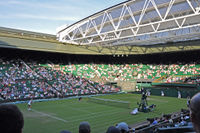
Wimbledon is widely considered to be the premier tennis tournament in the world and the priority of The All England Lawn Tennis Club, which hosts The Championships, is to maintain its leadership into the 21st century. To that end a long-term plan was unveiled in 1993, intended to improve the quality of the event for spectators, players, officials and neighbours.
Stage one of the plan was completed for the 1997 championships and involved building in Aorangi Park the new No. 1 Court, a broadcast centre, two extra grass courts and a tunnel under the hill linking Church Road and Somerset Road.
Stage two involved the removal of the old No. 1 Court complex to make way for the new Millennium Building, providing extensive facilities for the players, press, officials and members, and the extension of the West Stand of the Centre Court with 728 extra seats.
Stage three has been completed with the construction of an entrance building, housing club staff, museum, bank and ticket office.[7]
A new retractable roof was built in time for the 2009 championships, marking the first time in the tournament's history that rain will not stop play for a lengthly time on Centre Court. The All England Club tested the new roof at an event called A Centre Court Celebration on Sunday, 17 May 2009, which featured exhibition matches involving Andre Agassi, Steffi Graf, Kim Clijsters and Tim Henman. The first Championship match to take place under the roof was the completion of the fourth round women's singles match between Dinara Safina and Amélie Mauresmo. The first match to be played in its entirety under the new roof was between Andy Murray and Stanislas Wawrinka on 29 June 2009, which Murray won 2–6, 6–3, 6–3, 5–7, 6–3. The match in which Novak Djokovic defeated Olivier Rochus at Centre Court in the first round of the 2010 Championships recorded the latest ever finish at The Championships, concluding at 10.58pm.[8]
A new 4000-seat No. 2 Court was built on the site of the old No. 13 Court in time for the 2009 Championships.[9]
A new 2000-seat No. 3 Court is being built on the site of the old No. 2 Court and the old No. 3 Court.[10]
Events
Wimbledon includes five main events, four junior events and four invitation events.[11]
Main events
The five main events, and the number of players (or teams, in the case of doubles) include the following:
- Gentlemen's Singles (128 draw)
- Ladies' Singles (128 draw)
- Gentlemen's Doubles (64 draw)
- Ladies' Doubles (64 draw)
- Mixed Doubles (48 draw)
Junior events
Also known as Chimbledon (Children's Wimbledon), the four junior events and the number of players or teams include the following:
- Boys' Singles (64 draw)
- Girls' Singles (64 draw)
- Boys' Doubles (32 draw)
- Girls' Doubles (32 draw)
No mixed doubles event is held at this level.
Invitation events
The five invitational and the number of pairs include the following:
- Gentlemen's Invitation Doubles (8 pairs Round Robin)[12]
- Senior Gentlemen's Invitation Doubles (8 pairs Round Robin)[13]
- Ladies' Invitation Doubles (8 pairs Round Robin)
- Gentlemen's Wheelchair Doubles (4 pairs)[14]
- Ladies' Wheelchair Doubles (4 pairs)[14]
Match formats
Matches in the Gentlemen's Singles and Gentlemen's Doubles competitions are best-of-five sets. Matches in all other events are best-of-three sets. A tiebreak game is played if the score reaches 6–6 in any set except the fifth (in a five-set match) or the third (in a three-set match), in which case a two-game lead must be reached.
All events are single-elimination tournaments,[15] except for the Gentlemen's, Senior Gentlemen's and the Ladies' Invitation Doubles, all of which are round-robin tournaments.
Until 1922, the winners of the previous year's competition (except in the Ladies Doubles and Mixed Doubles) were automatically granted byes into the final round (then known as the challenge round). This led to many winners retaining their titles for successive years, as they were able to rest while their opponent competed from the start of the competition. From 1922, the prior-year's champions were not granted byes but were required to play all the rounds, like other tournament competitors.
Schedule
Each year, the tournament begins on the Monday falling between 20 and 26 June. Wimbledon begins two weeks after the Queen's Club Championships, which is one of the men's major warm-up tournaments for Wimbledon. Another important men's warm-up tournament is the Gerry Weber Open, which is held in Halle, Germany during the same week as the Queen's Club Championships. Other important grass-court tournaments before Wimbledon are Eastbourne, England, and 's-Hertogenbosch in the Netherlands, both combining mixed events. The other women's warm-up tournament for Wimbledon is Birmingham, also in England. And to bring the grass court season to an end after the Championships each year there is a tournament held overseas at Newport, Rhode Island, US.
Wimbledon is scheduled for 13 days, beginning on a Monday and ending on a Sunday with the middle Sunday a designated rest day. The five main events span both weeks, but the youth and invitational events are held mainly during the second week. Traditionally, there is no play on the "Middle Sunday", which is considered a rest day. However, rain has forced play on the Middle Sunday three times in the Championship's history: in 1991, 1997, and 2004. On each of these occasions, Wimbledon has staged a "People's Sunday", with unreserved seating and readily available, inexpensive tickets, allowing those with more limited means to sit on the show courts. Additionally, if the tournament is not completed by the end of the second Sunday, all remaining matches are postponed until "People's Monday".
Players and seeding
A total of 128 players feature in each singles event, 64 pairs in each single-sex doubles event, and 48 pairs in Mixed Doubles. Players and doubles pairs are admitted to the main events on the basis of their international rankings, with consideration also given to their previous performances at grasscourt events. Currently (since 2001) 32 male and female players are given seedings in the Gentlemen's and Ladies' singles while 16 teams are seeded in the doubles events.
The Committee of Management and the Referee evaluate all applications for entry, and determine which players may be admitted to the tournament directly. The committee may admit a player without a high enough ranking as a wild card. Usually, wild cards are players who have performed well during previous tournaments, or would stimulate public interest in Wimbledon by participating. The only wild card to win the Gentlemen's Singles Championship was Goran Ivanišević in 2001. Players and pairs who neither have high enough rankings nor receive wild cards may participate in a qualifying tournament held one week before Wimbledon at the Bank of England Sports Ground in Roehampton. The singles qualifying competitions are three-round events; the same-sex doubles competitions last for only one round. There is no qualifying tournament for Mixed Doubles. No qualifier has won either the Gentlemen's Singles or the Ladies' Singles tournaments. The furthest that any qualifier has progressed in the main draw of a Singles tournament is the semi-final round: John McEnroe in 1977 (Gentlemen's Singles), Vladimir Voltchkov in 2000 (Gentlemen's Singles), and Alexandra Stevenson in 1999 (Ladies' Singles).
Players are admitted to the junior tournaments upon the recommendations of their national tennis associations, on their International Tennis Federation world rankings and, in the case of the singles events, on the basis of a qualifying competition. The Committee of Management determines which players may enter the four invitational events.
The Committee seeds the top players and pairs on the basis of their rankings. However, the Committee does also change the seedings due to a player's previous grass court performance. A majority of the entrants are unseeded. Only two unseeded players have ever won the Gentlemen's Singles Championship: Boris Becker in 1985 and Goran Ivanišević in 2001. (In 1985 there were only 16 seeds and Becker was ranked 20th at the time; Ivanišević, however, was ranked 125th when he won as a Wild Card entrant.) No unseeded player has captured the Ladies' Singles title; the lowest seeded female champion was Venus Williams, who won in 2007 as the twenty-third seed, beating her own record from 2005, when Williams won as the fourteenth seed. Unseeded pairs have won the doubles titles on numerous occasions; the 2005 Gentlemen's Doubles champions were not only unseeded, but also (for the first time ever) qualifiers.
Grounds Schedule:
The grounds open at 10.30am on each day of playing. On the Centre Court, play starts at 1pm, with exception of the final two days of the competition (Ladies' and Gentlemen's Finals). On both of these days, play on these courts begins at 2pm. On courts 2-19, play begins at noon for at least the first eight days of the competition. It then starts at 11am for the Junior matches on the middle Saturday and during the second week.
Grounds
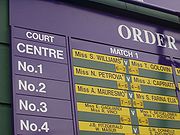
The nineteen courts used for Wimbledon are composed purely of rye grass.
The main show courts, Centre Court and No. 1 Court, are normally used only for two weeks a year, during the Championships, but play can extend into a third week in exceptional circumstances. The remaining seventeen courts are regularly used for other events hosted by the All England Lawn Tennis and Croquet Club. The show courts will, however, be pressed into action for the second time in three months in 2012 as Wimbledon will host the tennis events of the 2012 Olympic Games. One of the show courts is also used for home ties of the GB teams in the Davis Cup on occasions.
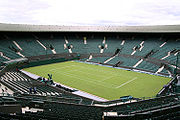
Wimbledon is the only Grand Slam event played on grass courts. At one time, all the Grand Slam events, except the French Open, were played on grass. The US Open abandoned grass for a synthetic clay surface in 1975 and changed again to a hard surface (DecoTurf) with its 1978 move to the National Tennis Center. The Australian Open abandoned grass for Rebound Ace, a different type of hard surface, in 1988, and switched to yet another type of hard surface, Plexicushion, in 2008.
The principal court, Centre Court, was opened in 1922 when the All England Lawn Tennis and Croquet Club moved from Worple Road to Church Road. The Church Road venue was larger and was needed to meet the ever-growing public demand.
Due to the possibility of rain during Wimbledon, a retractable roof was installed prior to the 2009 Championship. The retractable roof is designed to close/open in about 10 minutes and will be closed primarily to protect play from inclement (and, if necessary, extremely hot) weather during The Championships.[16] When the roof is being opened or closed, play is suspended. During a Wimbledon Championship match, the first time the roof was closed was on Monday 29 June 2009, involving Amélie Mauresmo and Dinara Safina. The court has a capacity of 15,000. At its south end is the Royal Box, from which members of the Royal Family and other dignitaries watch matches. Centre Court usually hosts the finals and semifinals of the main events, as well as many matches in the earlier rounds involving top-seeded players or local favourites.
The second most important court is No. 1 Court. The court was constructed in 1997 to replace the old No. 1 Court, which was adjacent to Centre Court. The old No. 1 Court was demolished because its capacity for spectators was too low. The court was said to have had a unique, more intimate atmosphere and was a favourite of many players. The new No. 1 Court has a capacity of approximately 11,000.
From 2009, a new No. 2 Court is being used at Wimbledon with a capacity for 4,000 people. To obtain planning permission, the playing surface is around 3.5m below ground level, ensuring that the single-storey structure is only about 3.5m above ground level, and thus not affecting local views.[17] Plans to build on the current site of Court 13 were dismissed due to the high capacity of games that will be played at the 2012 Olympic Games. The old No. 2 Court has been renamed as No. 3 Court. The old No. 2 Court was known as the "Graveyard of Champions" because many highly seeded players were eliminated there during early rounds over the years, including Ilie Năstase, John McEnroe, Boris Becker, Andre Agassi, Pete Sampras, Martina Hingis, Venus Williams, and Serena Williams.[18] The court has a capacity of 2,192 + 770 standing. In 2011 a new No. 3 Court and a new No. 4 Court will be unveiled on the sites of the old No. 2 and 3 courts.[19]
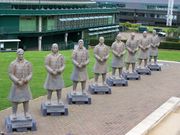
At the northern end of the grounds is a giant television screen on which important matches are broadcast. Fans watch from an area of grass officially known as the Aorangi Terrace. When British players do well at Wimbledon, the hill attracts fans for them, and is often re-named by the press for them: Greg Rusedski's followers convened at "Rusedski Ridge", and Tim Henman has had the hill nicknamed Henman Hill. As both of them have now retired and Andy Murray is the number 1 British player, the hill is now sometimes referred to as "Murray Mound" or "Murrayfield", as a reference to his Scottish heritage and the Scottish ground of the same name.
Traditions
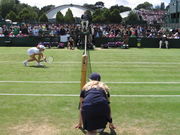
Ball boys and ball girls
In the championship games, ball boys and girls, known as BBGs, play a crucial role in the smooth running of the tournament, with a brief that a good BBG "should not be seen. They should blend into the background and get on with their jobs quietly."[20]
From 1947 ball boys were supplied by Goldings,[21] the only Barnardos school to provide them. Previous to this, from the 1920s onwards, the ball boys had been provided by The Shaftsbury Children's Home.
Since 1969, BBGs have been provided by local schools. As of 2008 they are drawn from schools in the London boroughs of Merton, Sutton, Kingston and Wandsworth, as well as from Surrey.[22] Traditionally, Wandsworth Boys Grammar School in Sutherland Grove, Southfields and Mayfield Girls School on West Hill in Wandsworth, both now defunct, were the schools of choice for selection of BBGs. This was possibly owing to their proximity to the All England Club. BBGs have an average age of 15, being drawn from the school years nine and ten. BBGs will serve for one, or if re-selected, two tournaments.
As of 2005, BBGs work in crews of six, two at the net, four at the corners, and crews rotate one hour on court, one hour off, (two hours depending on the court) for the day's play.[23] Crews are not told which court they will be working on the day, to ensure the same standards across all courts. With the expansion of the number of courts, and lengthening the tennis day, as of 2008, the number of BBGs required is around 250. BBG service is paid, with a total of £120-£160 being paid to each ball boy or girl after the 13-day period. Along with this it is seen as a privilege, and seen as a valuable addition to a school leaver's curriculum vitae, showing discipline. BBG places are split 50:50 between boys and girls, with girls having been used since 1977, appearing on centre court since 1985.[24]
Prospective BBGs are first nominated by their school headteacher, to be considered for selection. To be selected, a candidate must pass written tests on the rules of tennis, and pass fitness, mobility and other suitability tests, against initial preliminary instruction material. Successful candidates then commence a training phase, starting in February, in which the final BBGs are chosen through continual assessment. As of 2008, this training intake was 600. The training includes weekly sessions of physical, procedural and theoretical instruction, to ensure that the BBGs are fast, alert, self confident and adaptable to situations. As of 2007, early training occurs at Sutton Junior Tennis Centre, and then moves to the main courts after Easter.
Colours and uniforms
Dark green and purple (sometimes also referred to as mauve) are the traditional Wimbledon colours. However, all tennis players participating in the tournament are required to wear all white or at least almost all white clothing, a long time tradition at Wimbledon. Wearing white clothing with some colour accents is also acceptable. Green clothing was worn by the chair umpire, linesmen, ball boys and ball girls until the 2005 Championships; however, beginning with the 2006 Championships, officials, ball boys and ball girls were outfitted in new navy blue and cream coloured uniforms from American designer Ralph Lauren. This marked the first time in the history of the Championships that an outside company was used to design Wimbledon clothing. Wimbledon's contract with Polo Ralph Lauren is set to last until 2015.
Referring to players
Prior to 2009 female players were referred to by the title "Miss" or "Mrs" on scoreboards. As dictated by strict rule of etiquette, married female players are referred to by their husbands' names: for example, Chris Evert-Lloyd appeared on scoreboards as "Mrs. J. M. Lloyd" during her marriage to John Lloyd, since "Mrs. X" essentially designates "The Wife of X". This tradition has continued at least to some extent.[25] For the first time during the 2009 tournament, players were referred to on scoreboards by both their first and last names.[26] For example "Andy Murray", not "A. Murray".[27]
The title "Mr" is not used for male players who are professionals on scoreboards but the prefix is retained for amateurs, although chair umpires refer to players as "Mr" when they use the replay challenge. The chair umpire will say "Mr <surname> is challenging the call..." and "Mr <surname> has X challenges remaining." However, the umpires still say Miss <surname> when announcing the score of the Ladies matches.
If a match is being played with two competitors of the same surname (e.g. Venus and Serena Williams, Bob and Mike Bryan), the chair umpire will specify whom they are referring to by stating the player's first name and surname during announcements (e.g. "Game, Miss Serena Williams", "Advantage, Mike Bryan").
Royal Family
Previously, players bowed or curtsied to members of the Royal Family seated in the Royal Box upon entering or leaving Centre Court. In 2003, however, the President of the All England Club, His Royal Highness the Duke of Kent, decided to discontinue the tradition. Now, players are required to bow or curtsy only if Her Majesty the Queen or the Prince of Wales is present,[28] as was in practice during the 2010 Championships when the Queen was in attendance at Wimbledon on 24 June.[29][30]
Radio Wimbledon
Since 1992, Radio Wimbledon – an on-site radio station with a studio in the Centre Court building – has broadcast commentary, music and speech from 8am to 10pm daily throughout the championship. It also broadcast the draw on the Friday before the start of the tournament. Radio Wimbledon can be heard within a five-mile radius on 87.7 FM, and also online. It operates under a Restricted Service Licence and is arguably the most sophisticated RSL annually in the UK. The main presenters are Sam Lloyd and Ali Barton. Typically they work alternate four-hour shifts. Reporters and commentators include Gigi Salmon, Nick Lestor, Rupert Bell, Nigel Bidmead, Guy Swindells, Lucie Ahl, Nadine Towell and Helen Whitaker. Often they report from the "Crow's Nest", an elevated building housing the Court 3 and 4 scoreboards which affords views of most of the outside courts. Regular guests include Sue Mappin. In recent years Radio Wimbledon acquired a second low-power FM frequency (within the grounds only) of 96.3 FM for uninterrupted Centre Court commentary, and, from 2006, a third for coverage from No. 1 Court on 97.8 FM. Hourly news bulletins and travel (using RDS) are also broadcast.
Television coverage
For over 70 years, the BBC has broadcast the tournament on television in the UK, starting in 1937. The matches covered are split between its two main terrestrial channels, BBC One and BBC Two. The BBC holds the broadcast rights for Wimbledon until 2014 and it distributes its commercial-free feed to outlets worldwide. During the days of British Satellite Broadcasting, its sports channel carried extra coverage of Wimbledon for subscribers. One of the most notable British commentators was Dan Maskell, who was known as the BBC's "voice of tennis" until his retirement in 1991. Other regular commentators on UK television include British ex-players Greg Rusedski, Andrew Castle, Tim Henman and Annabel Croft; and guest veterans such as Boris Becker, John McEnroe, Jimmy Connors and Tracy Austin. The coverage is presented by Sue Barker and highlights with John Inverdale. Previous BBC presenters include Des Lynam, David Vine and Harry Carpenter.
The Wimbledon Finals are obliged to be shown live and in full on terrestrial television (BBC, ITV, Channel 4, Channel 5) by government mandate. Highlights of the rest of the tournament must be provided by terrestrial stations; live coverage (excepting the finals) may be sought by satellite or cable TV.[31]
Americans have made a tradition of NBC's "Breakfast at Wimbledon" specials at weekends, where live coverage starts early in the morning (the US being a minimum of 5 hours behind the UK) and continues well into the afternoon, interspersed with commentary and interviews from Bud Collins, whose tennis acumen and (in)famous patterned trousers are well-known to tennis fans in the USA. Collins was sacked by NBC in 2007, but was promptly hired by ESPN, the cable home for The Championships in the States. For many years NBC's primary Wimbledon host was veteran broadcaster Dick Enberg. From 1975 to 1999, premium channel HBO carried weekday coverage of Wimbledon. Hosts included Jim Lampley, Billie Jean King, Martina Navratilova, John Lloyd and Barry MacKay among others.[32]
Wimbledon was also involved, unintentionally, in a piece of television history, on 1 July 1967. That was when the first official colour broadcast took place in the UK. Four hours live coverage of Wimbledon was shown on BBC2 (then the only colour channel in the UK), and although footage of that historic match no longer survives, the Gentlemen's Final that year is still held in the BBC archives because it was the first Gentlemen's Final transmitted in colour.
Since 2007, the most anticipated Wimbledon matches have been transmitted in High Definition, on the BBC's free-to-air channel BBC HD, with continual live coverage during the tournament of Centre Court and Court No. 1 as well as an evening highlights show Today at Wimbledon.
In Ireland RTÉ broadcast the tournament during the 1980s and 1990s on their second channel RTÉ Two, they also provided highlights of the games in the evening. RTÉ made the decision in 1998 to discontinue broadcasting the tournament due to falling viewing figures and the large number of viewers watching on the BBC.[33] Since 2005 TG4 Ireland's Irish language broadcaster provide coverage to the tournament. Live coverage is provided through the Irish language while they broadcast highlights in English at night.[34]
The BBC's opening theme music for Wimbledon was composed by Keith Mansfield and is titled "Light and Tuneful". A piece titled "A Sporting Occasion" is the traditional closing theme, though nowadays coverage typically ends either with a montage set to a popular song or with no music at all.
Tickets
The majority of centre and show court tickets sold to the general public are made available by a public ballot that the All England Club holds at the start of the year. A ballot for tickets has been held since 1924.
The ballot has always been substantially oversubscribed. Successful applicants are selected at random by a computer.[35]
The All England Club, through its subsidiary The All England Lawn Tennis Ground plc, issues Debentures to tennis fans every five years to raise funds for capital expenditure. Fans who invest thus in the club receive a pair of tickets for every day of the Wimbledon Championships for the five years the investment lasts.[36] Only debenture holders are permitted to sell on their tickets to third parties, although for many years ticket touts have made a habit of illegally purchasing tickets allocated to non-debenture holders in the draw and selling them for a profit. Demand for debentures has increased in recent years, to such an extent that they are even traded on the London Stock Exchange.
Wimbledon is the only Grand Slam where fans without tickets for play can queue up and still get seats on Centre Court, Court 1 and Court 2. From 2008, there is a single queue, allotted about 500 seats for each court. When they join the queue fans are handed vouchers with a number on it and the following morning when the line moves towards the Grounds, stewards come through the line and hand out wristbands colour-coded to the specific court. The voucher is then redeemed at the ticket office for the ticket.
To get into the show courts, fans will normally have to queue overnight at Wimbledon,[37] This is done by fans from all over the world and is considered part of the Wimbledon experience in itself. Those planning to queue overnight are advised to bring a tent and sleeping bag. Times to queue up vary according to the weather, but anyone queueing up before 9 pm on a weekday should be able to get a show court ticket. Queuing for the show courts ends after the quarter finals have been completed.
At 2.40pm on Day Seven (Monday 28 June) of the 2010 Championships, the one-millionth numbered Wimbledon queue card was handed out[38] to Rose Stanley from South Africa. Queue cards were introduced in 2003 and have been numbered sequentially since so people didn't need to wait in an actual line - this decision meant that people can potentially collect a queue card, then go home to 'queue'.
The All-England Club take a strange stance on queueing. They do not endorse overnight queueing however, they provide toilet and water facilities for people who do camp overnight. Should a camper be successful in obtaining a ticket, the Club also provides unattended baggage storage where items not allowed into the grounds (including camping equipment such as tents) can be left while matches are in progress.
Trophies and prize money
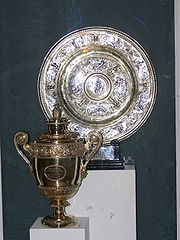
The Gentlemen's Singles champion receives a silver gilt cup 18.5 inches (about 47 cm) in height and 7.5 inches (about 19 cm) in diameter. The trophy has been awarded since 1887 and bears the inscription: "All England Lawn Tennis Club Single Handed Championship of the World." The Ladies' Singles champion receives a sterling silver salver commonly known as the "Venus Rosewater Dish", or simply the "Rosewater Dish". The salver, which is 18.75 inches (about 48 cm) in diameter, is decorated with figures from mythology. The winners of the Gentlemen's Doubles, Ladies' Doubles, and Mixed Doubles events receive silver cups. The runner-up in each event receives an inscribed silver plate. The trophies are usually presented by the President of the All England Club, The Duke of Kent.
Prize money was first awarded in 1968, the first year that professional players were allowed to compete in the Championships.[39]
Prior to 2007, among grand slam tournaments, Wimbledon and the French Open awarded more prize money in men's events than in women's events. In 2007, Wimbledon changed this policy, giving the same money for both events.[40] There has been considerable controversy with people complaining that men play two thirds more sets than women at the tournament and thus now earn far less per hour than their female counterparts. However, tennis players are not paid by the hour and those who play longer or shorter games, sets or matches are not rewarded accordingly.[41][42][43]
In 2009, a total of £12,500,000 in prize money was awarded with the singles champions receiving £850,000 each, an increase of 13.3 percent on 2008.[44]
For the 2010 Championships, the total prize money increased to £13,725,000, and the singles champions will receive £1,000,000 each[45]
Champions
- Main article: List of Wimbledon champions (and the Championships by year)
- Gentlemen's Singles[46]
- Ladies' Singles[47]
- Gentlemen's Doubles
- Ladies' Doubles
- Mixed Doubles
- Singles Finals
Current champions
 Rafael Nadal is the Gentleman's champion, after defeating Czech Tomas Berdych in straight sets. This is Nadal's second Wimbledon Gentlemen's Singles title and the eighth slam of Nadal's career. This is the second time in Nadal's career that he has completed the French Open – Wimbledon double, which he did back in 2008. |
 Serena Williams is the Ladies' champion, after defeating Russian Vera Zvonareva in straight sets. This is Serena's fourth Wimbledon Women's Singles title and ninth Wimbledon title of her career. This win was her 13th Grand Slam win, taking her past Billie Jean King to sixth in the all-time list of female Grand Slam singles champions. Earlier this year she also won the Australian Open, the same as in 2009. |
 Jürgen Melzer part of the winning Men's Doubles team in 2010. This is his first men's doubles slam title, which he did win two junior slams. |
 Philipp Petzschner part of the winning Men's Doubles team in 2010. This is his first men's doubles slam title, which he did win one junior slam. |
 Vania King part of the winning Women's Doubles team in 2010. This is her first slam title and Wimbledon title. |
Yaroslava Shvedova part of the winning Women's Doubles team in 2010. This is her first slam title and Wimbledon title. |
 Leander Paes part of the winning Mixed Doubles team in 2010. This is his third Wimbledon Mixed Doubles title and fourth Wimbledon title in his career with the Men's Doubles win in 1999. In addition, Paes won sixth mixed doubles title for his career, and he won the Australian Open in Mixed Doubles in 2010. |
 Cara Black part of the winning Mixed Doubles team in 2010. This is her second Wimbledon Mixed Doubles title and her fifth Wimbledon title of her career to go along with her three Ladies' Doubles titles. Additionally, Black won her fifth career mixed doubles title for her career, which she won the 2010 Australian Open Mixed Doubles. |
| Event | Champion | Runner-up | Score |
|---|---|---|---|
| 2010 Men's Singles | 6–3, 7–5, 6–4 | ||
| 2010 Women's Singles | 6–3, 6–2 | ||
| 2010 Men's Doubles | 6–1, 7–5, 7–5 | ||
| 2010 Women's Doubles | 7–6(6), 6–2 | ||
| 2010 Mixed Doubles | 6–4, 7–6(5) |
Records
| Record | Era | Player(s) | Count | Winning years |
|---|---|---|---|---|
| Gentlemen since 1877 | ||||
| Winner of most Gentlemen's Singles titles | Before 1968: | 7 | 1881, 1882, 1883, 1884, 1885, 1886, 1889 | |
| After 1968: | 7 | 1993, 1994, 1995, 1997, 1998, 1999, 2000 | ||
| Winner of most consecutive Gentlemen's Singles titles | Before 1968: | 6 | 1881, 1882, 1883, 1884, 1885, 1886 | |
| After 1968: | 5 | 1976, 1977, 1978, 1979, 1980 2003, 2004, 2005, 2006, 2007 |
||
| Winner of most Gentlemen's Doubles titles | Before 1968: | 8 | 1897, 1898, 1899, 1900, 1901, 1903, 1904, 1905 | |
| After 1968: | 9 | 1993, 1994, 1995, 1996, 1997, 2000 (with Mark Woodforde), 2002, 2003, 2004 (with Jonas Björkman) | ||
| Winner of most consecutive Gentlemen's Doubles titles | Before 1968: | 5 | 1897, 1898, 1899, 1900, 1901 | |
| After 1968: | 5 | 1993, 1994, 1995, 1996, 1997 | ||
| Winner of most Mixed Doubles titles – Gentlemen | Before 1968: |
|
4 | 1963, 1965, 1966, 1968 (with Margaret Court)
1953, 1954, 1955, 1956 (3 with Doris Hart, 1 with Shirley Fry Irvin) |
| After 1968: | 4 | 1967, 1971, 1973, 1974 (with Billie Jean King) | ||
| Winner of most Championships (total: singles, doubles, mixed) – Gentlemen | Before 1968: | 14 | 1880–1889 (7 singles, 7 doubles) | |
| After 1968: | 9 | 1993–2004 (9 doubles) | ||
| Ladies since 1884 | ||||
| Winner of most Ladies' Singles titles | Before 1968: | 8 | 1927, 1928, 1929, 1930, 1932, 1933, 1935, 1938 | |
| After 1968: | 9 | 1978, 1979, 1982, 1983, 1984, 1985, 1986, 1987, 1990 | ||
| Winner of most consecutive Ladies' Singles titles | Before 1968: | 5 | 1919, 1920, 1921, 1922, 1923 | |
| After 1968: | 6 | 1982, 1983, 1984, 1985, 1986, 1987 | ||
| Winner of most Ladies' Doubles titles | Before 1968: | 12 | 1914 (with Agatha Morton), 1919, 1920, 1921, 1922, 1923, 1925 (with Suzanne Lenglen), 1926 (with Mary Browne), 1927, 1930 (with Helen Wills), 1933, 1934 (with Simone Mathieu) | |
| 10 | 1961, 1962 (with Karen Hantze Susman), 1965 (with Maria Bueno), 1967, 1968, 1970, 1971, 1973 (with Rosie Casals), 1972 (with Betty Stöve), 1979 (with Martina Navrátilová) | |||
| After 1968: | 7 | 1976 (with Chris Evert), 1979 (with Billie Jean King), 1981, 1982, 1983, 1984, 1986 (with Pam Shriver) | ||
| Winner of most consecutive Ladies' Doubles titles | Before 1968: | 5 | 1919, 1920, 1921, 1922, 1923 | |
| After 1968: |
|
4 | 1981, 1982, 1983, 1984
1991 (with Larisa Neiland), 1992, 1993, 1994 (Gigi Fernández) |
|
| Winner of most Mixed Doubles titles – ladies | Before 1968: | 7 | 1919, 1921, 1923 (with Randolph Lycett), 1927 (with Frank Hunter), 1928 (with Patrick Spence), 1930 (with Jack Crawford), 1932 (with Enrique Maier) | |
| After 1968: | 4 | 1985 (with Paul McNamee), 1993 (with Mark Woodforde), 1995 (with Jonathan Stark), 2003 (with Leander Paes) | ||
| Winner of most Championships (total: singles, doubles, mixed) – ladies | Before 1968: | 20 | 1961–79 (6 singles, 10 doubles, 4 mixed) | |
| 19 | 1914–34 (12 doubles, 7 mixed) | |||
| After 1968: | 20 | 1976–2003 (9 singles, 7 doubles, 4 mixed) | ||
| Miscellaneous | ||||
| Most games won in a final | 39 | 2009 | ||
| Most matches played (men) | 223 | 1922–39, 1948–64 | ||
| Most matches played (women) | 326 | |||
| Loser of most singles finals (men or women) | 7 | 1885, 1887, 1888, 1891, 1892, 1893, 1901 1973, 1978, 1979, 1980, 1982, 1984, 1985 |
||
| Lowest-ranked winner (men or women) | 125th | 2001 | ||
| Wildcard winner (men or women) | 2001 | |||
| Lowest-ranked winner (women) | 31st (23rd seed) | 2007 | ||
| Youngest winner (men) | 17 | 1985 | ||
| Youngest winner (Ladies' Singles) | 15 | 1887 | ||
| Youngest winner (Ladies' Doubles) | 15 | 1996 | ||
| Longest men's final by time | 4hrs 48mins | 2008 | ||
| Longest men's match by time | 11hrs 5mins | 2010 | ||
| Longest men's final by games | 77 games | 2009 | ||
| Longest men's match by games | 183 games | 2010 | ||
| Longest women's final by time | 2hrs 45mins | 2005 | ||
| Longest semifinal (women) | 2hrs 49mins[49] | 2009 | ||
Singles champions never World No. 1
- According to Wallis Myers of The Daily Telegraph and the Daily Mail[50] and the computer rankings of the Women's Tennis Association, only seven women have won the Wimbledon singles title since 1921 but never reached the World No. 1 ranking. (Since Wimbledon's "Open Era" (1968), only four of the 16 winners haven't reached WTA World No. 1.) These are, in chronological order: Kathleen McKane Godfree, Cilly Aussem, Karen Hantze Susman, Ann Haydon Jones, Virginia Wade, Conchita Martínez, and Jana Novotná.
- The men fared differently. Although the men ranked World No. 1 have been dominant in Wimbledon (11 out of the 19 winners), the Open Era features a mixed fortune of champions. Three champions reached a career high of World No. 2, Arthur Ashe, Goran Ivanišević, and Michael Stich. Richard Krajicek and Pat Cash, who both reached a career high of World No. 4, have also won the singles championship. One singles champion, Jan Kodeš, reached a career high of only World No. 5 (the lowest career-rank of a winner of the Wimbledon Men's Singles); he won in 1973 when many high-ranking players were absent.
See also
- 2010 Wimbledon Championships
- List of Wimbledon champions
- Wimbledon Effect
- 2012 Summer Olympics venues
- Wimbledon court surfaces
Notes and references
- ↑ This means that, in the men's main draws, there are 128 singles (S) and 64 doubles (D), and there are 128 and 16 entrants in the respective qualifying (Q) draws.
- ↑ Clarey, Christopher (7 May 2008). "Traditional Final: It's Nadal and Federer". The New York Times. http://www.nytimes.com/2008/07/05/sports/tennis/05wimbledon.html?ref=tennis. Retrieved 17 July 2008. "Federer said[:] 'I love playing him, especially here at Wimbledon, the most prestigious tournament we have.'"
- ↑ Will Kaufman & Heidi Slettedahl Macpherson, ed (2005). "Tennis". Britain And The Americas. 1 : Culture, Politics, and History. ABC-CLIO. pp. 958. ISBN 1851094318. "this first tennis championship, which later evolved into the Wimbledon Tournament ... continues as the world's most prestigious event.".
- ↑ "Wimbledon's reputation and why it is considered the most prestigious". Iloveindia.com. http://www.iloveindia.com/sports/wimbledon/index.html. Retrieved 14 September 2010.
- ↑ "Djokovic describes Wimbledon as "the most prestigious event"". BBC News. 26 June 2009. http://news.bbc.co.uk/sport1/hi/tennis/8121289.stm. Retrieved 14 September 2010.
- ↑ Wimbledon home page http://www.wimbledon.org/en_GB/about/history/history.html
- ↑ Wimbledon home page http://www.wimbledon.org/en_GB/about/history/history.html
- ↑ Caroline Davies (21 June 2010). "Wimbledon 2010: Normal service resumed, just | Sport". The Guardian (UK). http://www.guardian.co.uk/sport/2010/jun/21/wimbledon-2010-normal-service-resumed. Retrieved 26 July 2010.
- ↑ New Court No. 2
- ↑ "The New Court 3". Blog.wimbledon.org. http://blog.wimbledon.org/2010/03/26/the-new-court-3. Retrieved 14 September 2010.
- ↑ "Wimbledon Event Guide". wimbledon.org. http://www.wimbledon.org/en_GB/about/guide/eventguide.html. Retrieved 12 November 2010.
- ↑ The men who are eligible for the Gentlemen's Invitation Doubles are 35 years old and older.
- ↑ The men who are eligible for the Senior Gentlemen's Invitation Doubles are 45 years old and older.
- ↑ 14.0 14.1 There are no age limits for the Wheelchair Doubles events.
- ↑ In a single-elimination tournament, a losing player or team is eliminated from the tournament.
- ↑ "Wimbledon Website – The Championships and The All England Lawn Tennis Club<". Wimbledon.org. 23 September 2007. http://www.wimbledon.org/en_GB/about/guide/longtermplan.html. Retrieved 14 September 2010.
- ↑ Wimbledon Press Release
- ↑ "How the ‘Graveyard of champions’ got its name". Blog.wimbledon.org. http://blog.wimbledon.org/2009/05/26/how-the-graveyard-of-champions-got-its-name. Retrieved 14 September 2010.
- ↑ "Wimbledon Debentures - About Debentures - The Long Term Plan". Aeltc.com. http://www.aeltc.com/cms/debentures/about/longtermplan.aspx. Retrieved 26 July 2010.
- ↑ The Telegraph Strawberries, cream and BBGs, 29 June 2006
- ↑ "Goldings Ballboys". Goldonian.org. 26 June 2004. http://www.goldonian.org/wimbledon/goldings_ballboys.htm. Retrieved 14 September 2010.
- ↑ Official Site Ballboys and Ballgirls Schools Information
- ↑ Official Site Ballboys and Ballgirls Background Information
- ↑ Official Site About Wimbledon – Behind the scenes, Ball boys and ball girls
- ↑ "Mrs. P-Y Hardenne" is used to describe Justine Henin. See [1]. Retrieved 12 November 2010.
- ↑ [2]
- ↑ See scoreboard behind Andy Murray during his third round match with Stanilsas Wawrinka [3] . Retrieved 30 June 2009.
- ↑ "Wimbledon Website - The Championships and The All England Lawn Tennis Club". Wimbledon.org. 23 September 2007. http://www.wimbledon.org/en_GB/about/infosheets/royalbox.html. Retrieved 14 September 2010.
- ↑ [4]
- ↑ Eden, Richard (15 May 2010). "Advantage Andy Murray as the Queen visits Wimbledon". London: Telegraph. http://www.telegraph.co.uk/sport/tennis/andymurray/7728927/Advantage-Andy-Murray-as-the-Queen-visits-Wimbledon.html. Retrieved 26 July 2010.
- ↑ "Corel Office Document" (PDF). http://www.culture.gov.uk/PDF/sport_on_television.pdf. Retrieved 26 July 2010.
- ↑ HBO Guides, program schedules, 1975 to 1999
- ↑ "Tennis - set for change?". The Irish Times. 8 July 1998. http://www.irishtimes.com/newspaper/sport/1998/0708/98070800158.html. Retrieved 22 June 2010.
- ↑ "TG4'S SUCCESSFUL TENNIS COVERAGE TO CONTINUE WITH WIMBLEDON 2009". TG4. 20 June 2009. http://www.tg4.ie/bearla/corp/pr/2009/0620-1.asp. Retrieved 2 June 2010.
- ↑ Wimbledon website http://www.wimbledon.org/en_GB/about/tickets/ballot.html
- ↑ "Wimbledon Debentures - About Debentures - About Wimbledon Debentures". Aeltc.com. http://www.aeltc.com/cms/debentures/about/About.aspx. Retrieved 26 July 2010.
- ↑ queue overnight at Wimbledon http://blog.nationmultimedia.com/natee/2007/07/16/entry-1
- ↑ One-Millionth queue card handed out http://2010.wimbledon.org/en_GB/news/blogs/2010-06-29/201006291277811866606.html
- ↑ "The Championships, Wimbledon 2008 — Prize Money history". wimbledon.org. 21 September 1998. http://www.wimbledon.org/en_GB/about/history/prizemoney_history.html. Retrieved 12 November 2010.
- ↑ "The Championships, Wimbledon 2009 - 2009 Prize money". Aeltc2009.wimbledon.org. http://aeltc2009.wimbledon.org/en_GB/about/guide/prizemoney.html. Retrieved 26 July 2010.
- ↑ Galway racing tips (23 June 2009). "Some are more equal than others... - Lifestyle, Frontpage". The Irish Independent. http://www.independent.ie/lifestyle/some-are-more-equal-than-others-1784792.html. Retrieved 26 July 2010.
- ↑ "Women Don't Deserve Equal Prize Money at Wimbledon". Bleacher Report. 2 July 2009. http://bleacherreport.com/articles/210746-women-dont-deserve-equal-prize-money-at-wimbledon#poll. Retrieved 26 July 2010.
- ↑ Newman, Paul (23 June 2006). "The Big Question: Should women players get paid as much as men at Wimbledon?". The Independent (London). http://www.independent.co.uk/sport/tennis/the-big-question-should-women-players-get-paid-as-much-as-men-at-wimbledon-405067.html. Retrieved 25 May 2010.
- ↑ "2009 Championships Prize Money". Aeltc2009.wimbledon.org. http://aeltc2009.wimbledon.org/en_GB/about/guide/prizemoney.html. Retrieved 14 September 2010.
- ↑ "The Championships, Wimbledon 2009 - 2009 Prize money". Aeltc2010.wimbledon.org. http://aeltc2010.wimbledon.org/en_GB/about/guide/prizemoney.html. Retrieved 26 July 2010.
- ↑ Last British Gentlemen's Singles champion: Fred Perry (1936)
- ↑ Last British Ladies' Singles champion: Virginia Wade (1977)
- ↑ In Renshaw's era, the defending champion was exempt from playing in the main draw, playing only in the final. This policy was abolished in 1922.
- ↑ "Wimbledon: Serena Williams fights back to beat Elena Dementieva - ESPN". Sports.espn.go.com. 2 July 2009. http://sports.espn.go.com/sports/tennis/wimbledon09/columns/story?columnist=ubha_ravi&id=4302223. Retrieved 26 July 2010.
- ↑ Collins, Bud (2008). The Bud Collins History of Tennis: An Authoritative Encyclopedia and Record Book. New York, N.Y: New Chapter Press. pp. 695, 701–4. ISBN 0-942257-41-3.
Further reading
- Robertson, Max Wimbledon 1877–1977
External links
- Official site
- Official blog
- 3D Map of the Grounds
- Satellite image of the venue (Google Maps)
- BBC Five Live's coverage of Wimbledon
- Simulation of the new centre court
- Goldings' Wimbledon Ball Boys
- Wimbledon – All winners and runners-up. Reference book
| Preceded by French Open |
Grand Slam Tournament June–July |
Succeeded by U.S. Open |
|
||||||||||||||||||||||||||||||||||||||||||||||||||||||||||||||||||||||||||||||||||||||||||||||||||||||||||||||||||
|
||||||||||||||||||||||||||||||||||||||||||||||||||||||||||||||||||||||
|
||||||||||||||||||||||||||||||||||||||||||||||||||||||||||||||||||||||||||||||||||||||||||||||||||||||||||||||||||||||||||||||||||||||||||
|
||||||||
|
||||||||||||||||||||||||||||||||||
|
|||||||||||||||||||||||||||||||||||||
